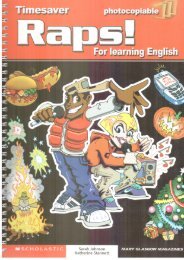English_Book_2-Teacher_300913
English_Book_2-Teacher_300913
English_Book_2-Teacher_300913
You also want an ePaper? Increase the reach of your titles
YUMPU automatically turns print PDFs into web optimized ePapers that Google loves.
TEACHER’S NOTES2 Comprehension (10 min.)A.• Have students read the directions and then workindividually to complete the exercise. Check theanswers orally.Answer key1. 52. 13. 24. 45. 3B.• Tell students to write short answers to thequestions. You may want to ask students tochallenge themselves by answering the questionsin this exercise without looking back at the text.• Check answers as a class. Ask volunteers toread aloud the passage in the text that answersthe question.Answer key1. At 6:302. Cereal or a banana3. Practices track and field and goes to the gym.4. Track and field / running• Ask students if they could guess the meaningsof some of the new vocabulary. Ask whichwords were new to them. Elicit guesses as to themeanings of words like alarm, goes off, turn it off,take a shower, get dressed, brush my teeth, sometimes,usually, grab (get something quickly), exactly, late,get home, track and field, competition, don’t mind,and lazy. Teach the meanings of any terms thatstudents were not able to guess.3 Pronunciation (15 min.)A.• Explain that there are three differentpronunciations for the -s endings for simplepresent, third person. The pronunciation dependson the last sound of the word the -s is added to.• In one column on the board, write several verbsthat end in sibilant sounds—/s/, /ʃ/, //, /z/—such as practice (/s/), brush (/ʃ/), watch (//), andclose (/z /). These endings have a hissing sound.Write and say the third person present forms ofthe verbs. Point out that the -s ending in thesekinds of words is pronounced /iz /.• Model the pronunciation of each verb with the/iz/ ending, then ask students to repeat. Askstudents to pronounce the words with their fingerstouching the front of their throats. Point out thatthere is a buzzing feeling in the throat when the/iz/ sound is made.• Next, in another column, write several verbsending in voiceless consonant sounds—/p/, /t/,/k/, /f/—such as sleep (/p/), get (/t/), compete(/t/), think (/k/), like (/k/), and laugh (/f/).When we pronounce voiceless consonants, ourvocal chords do not move or vibrate. Ask studentsto put their fingers on the front of their throats asthey say the last sounds of the words. Point outthat there is no buzzing feeling in the throat whenthese sounds are made. Tell students that the -sending is pronounced /s/ in words like these. Onthe board, add an -s to each of these verbs.Model the pronunciation of each, then askstudents to repeat.• Do the same with verbs ending in voiced sounds:grab / b/, run /n/, ring /ŋ/, call /l/, imagine/n/, end /d/, love /v/, stay /ei/. Point out thatthere is a buzzing feeling in the throat when wepronounce the last sounds of these words. Tellstudents that the -s ending is pronounced /z/ inwords like these. Model the pronunciation of eachverb with the /z/ ending, then ask students torepeat with their fingers touching the front of theirthroats to feel the vibration.• 22 Play the audio a couple of times, pausingfor students to repeat the words. Help withpronunciation as needed.B.• 23 Call on a student to read the directions aloud.Then play the audio, pausing for students to circlethe verbs with the /z/ or /iz/ sound.• Check answers by calling on individual students;elicit the ending sound and write it on the board.Answer key1. leaves /z/2. goes /z/3. watches /iz/C.• 24 Play the audio again and have studentsrepeat the sentences. Then have students formpairs. Tell pairs to take turns. If students needmore practice, have them change roles severaltimes. Check by calling on individuals to read thesentences aloud.T15Postcards_splitB_TE1_U02.indd T152/27/07 10:22:07 AM




